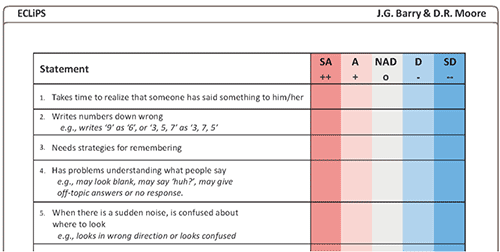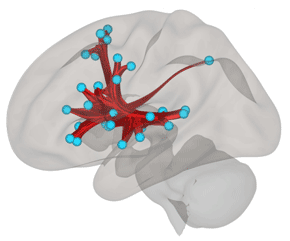Sensitive Indicators of Childhood Listening Difficulties (SICLiD) Study
Quite a few children with listening difficulties turn out to have clinically normal hearing. These children currently pose a problem for clinical services as it is unclear how they should be treated. Currently, they are sometimes given a series of tests for ‘auditory processing disorder’ (APD). However, the relationship between those tests and the symptoms reported by the children and their families is unclear.
Alternately, they may be referred on to other children’s services (e.g. speech/language pathology, developmental psychology), but those services may also be uncertain how to respond. In this study we are assessing listening ability in a sample of children with normal audiograms using a reliable and validated caregiver questionnaire the ECLiPS. The results are related to a series of research tests of the children’s hearing, thinking (cognition), and auditory system biology – ear and brain function. Brain function was studied using MRI. We have found strong evidence from these tests that the children with listening difficulties, but with normal hearing, have impaired forebrain function indicative of impaired cognition rather than impaired hearing.

 The ECLiPS caregiver questionnaire (above) allows us to screen for listening difficulties in children. Caregivers indicate whether they strongly agree (SA) to strongly disagree (SD) with 38 statements about their children.
The ECLiPS caregiver questionnaire (above) allows us to screen for listening difficulties in children. Caregivers indicate whether they strongly agree (SA) to strongly disagree (SD) with 38 statements about their children.
We can visualize connections between active brain areas in children (left) using magnetic resonance imaging (MRI). Here, the connections (red) between speech processing areas (blue) are averaged across more than 40 typically developing children aged 6 -13 years.
Audiological Measures in Children with Listening Difficulties
In the Listening lab, Dr. Hunter is collaborating to uncover hearing issues that may relate to children’s listening problems. She uses sensitive tests that have been developed in her previous collaborations with Dr. Doug Keefe at Boys Town National Research Hospital in Omaha, NE and Dr. Pat Feeney at the National Center for Rehabilitative Audiologic Research in Portland, OR. These tests are capable of detecting very high frequency changes in hearing sensitivity, problems in the function of the eardrum and middle ear, and in the inner ear.
In the SICLiD study, she recently published results showing overall that children with listening difficulties do not have problems in these areas that could explain their difficulty in understanding. However, some children had poorer high frequency hearing sensitivity, poorer inner ear and middle ear function that were clearly related to previous history of otitis media treated with eardrum tubes.
Dr. Hunter is also collaborating on the OtiS study to study children who could benefit from the new hearing aids due to problems they have understanding speech in noise.
Speech Envelope Tracking in Children with Listening Difficulties
There are many children with listening difficulties (LiD) who have clinically normal hearing. A primary concern of parents of children with LiD is their difficulty listening in class. A critical cue of selective attention to speech is the low-frequency (<10 Hz) fluctuation of speech amplitude, the so-called speech envelope.
We hypothesize that children with LiD may have difficulty processing speech envelope in their brains. We are going to assess the brain’s response to speech envelope in children with LiD using magnetoencephalography (MEG).
Collaborators and Funding
Collaborators: Lauren Petley, PhD (Clarkson University), Andrew Dimitrijevic, PhD (University of Toronto), Hannah Stewart, PhD (University College London), Barbara Shinn-Cunningham (Carnegie-Mellon University)
Funding: NIH (DC014078), CCH Research Foundation, Hearing Health Foundation, CCTST JIT Pilot Grant.



